MAVERICK CITIZEN OP-ED
‘We thanked the ancestors for their opinion’: Amadiba locals stand their ground over N2 Wild Coast Toll Road
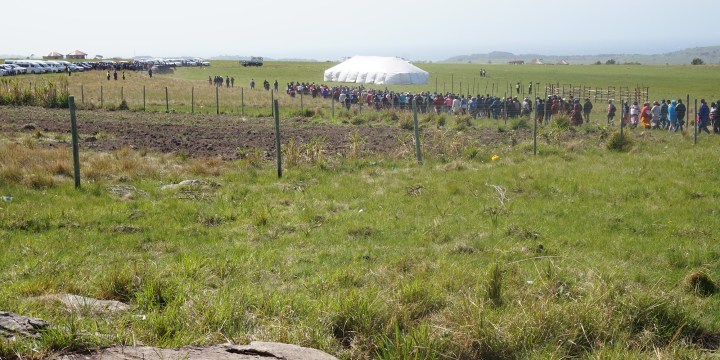
The crisis committee from the Amadiba coast in the Eastern Cape’s Mbizana municipality faced public order police stun grenades and intimidation as they fought a battle against the proposed development of their land.
Nonhle Mbuthuma is from Sigidi village on the Wild Coast. She is the spokesperson of the Amadiba Crisis Committee (ACC) and was one of three women elected to its executive committee when the ACC in 2007 was founded at Komkhulu (the Great Place) of Umgungundlovu, which is the coastal section of Amadiba. Today, most of the ACC executive are women.
We have read the article published in Daily Maverick reporting on the 10 September “stakeholder” meeting in Sigidi village on the Eastern Cape’s Wild Coast.
The province’s MEC of Public Works, Babalo Madikizela, had announced that a “community meeting” would take “a majority vote to decide” on this day as to whether the proposed N2 Wild Coast Toll Road shall pass through Sigidi village or not, splitting it in two halves 3km from the coast with an 80m fenced-off 120km/h highway, or if the N2 should be moved inland to the middle of the Amadiba administrative area.
After the “vote” he would decide, as if he or Sanral would ever accept to lose a vote. A proper negotiation is needed. The Amadiba Crisis Committee (ACC) has a proposal for the N2 to run through the middle of Amadiba. We are assisted by experts.
The MEC’s “community meeting” became the usual “stakeholder meeting” running five hours late. At 3pm, he finally held his meeting with the Mzamba Taxi Owners Association, businessmen and “trusts” that attend the political caucuses of Minister of Mineral and Energy Resources Gwede Mantashe and national roads agency Sanral.
People in Mbizana soon know the truth about an event like this, but I will give background and describe the day in more detail.
As soon as the ACC arrived with everyone at 10am, the plans were changed. The MEC did not like his “community imbizo” any longer. He got into a political panic. He started to make phone calls.
However, hundreds of people stayed on, singing and waiting without food from early morning to late afternoon.
The events as they unfolded
The community meeting never got off the ground. The wind pulled down the big tent it was supposed to be held in. We thanked the ancestors for their opinion.
The night before, a man who turned out to be a security guard, had called a leader in Sigidi: “The tent is up. Let’s go and burn it down.” We are used to provocations. The word went out: “Don’t go near the tent.”
We were singing. The local police were watching. There were some discussions with people who had been promised jobs and brought their IDs. After more than two hours of waiting, people got tired. One argument led to a fight. The police shot stun grenades and threw pepper canisters “to separate the two groups”. A man siding with the Sanral camp, who was drunk, was put in a police van.
An elder had a hole ripped in his jacket from a stun grenade. Luckily it was thick. The children of Sigidi Primary School ran home from their classes. A week later the parents tell us that their children still can’t sleep.
The commander, a Lieutenant-Colonel John, came over to tell us not to distribute alcohol. But we had nothing. The many bottles handed out were not with us. There was no beer sold at the Sigidi spaza shop on 10 September.
This was intentional. The question is who was bringing in case after case of beer and even brandy. It was targeted at the young boys of Sigidi. We had boys pushing wheelbarrows with beer. Our elders have told us: “This is how the apartheid government stole land. They had the traditional chief completely drunk. Then he signed away the land.” This is also how Wild Coast Sun and Lurholweni township were built in Amadiba.
We soon went over to John again, together with our lawyers Zolile Shude and Elisha Kunene. There was no meeting. People had waited calmly, but now they started to be fed up. We suggested to John and his operative commander, tell people to go home.
“This is a good idea!” they said. “We will talk to the MEC.” They came back: “No, he has called for the Public Order Police (POP). The meeting is going ahead.”
The POP arrived by 2pm in a Nyala marked “Lusikisiki”. It must have been on the road since at least 11am. They even had time to get lost. First they went to the Xolobeni sports field. The MEC had called in reinforcement, hours before our discussion with the responsible SAPS commander. The MEC was commanding the police.
Five minutes after John told us that SAPS “cannot politically interfere”, I got a call from someone in the security cluster, alleging that an incident had been planned.
“Listen. Police from the outside are coming. It will happen when they ask you to leave the others. They think the crisis committee will refuse. The police that is coming have orders to finish their bullets on your body. Please, leave now.”
When they arrived and came out, the POP pointed their rifles right at us, nobody could pass through.
John returned at 3pm. “The MEC wants five from the ACC.” There was an intense discussion. We convinced comrades we would go to see what was going on. The death threat influenced the decision. Our group walked past the POP.
One of them shouted: “Are you Nonhle?”
“Yes, and so what?!”
Our two security guards stood near them and overheard: “That one is Nonhle. We will deal with her.”
Some 50 people attended the MEC’s meeting with business forums, the “trusts” and leaders of the local mining lobby. The MEC repeated what he said in Sigidi on 7 June when he set out to facilitate a negotiation with Sanral: “Nobody can force development against the majority!” and concluded: “We have the majority.” But anyway, “the government has already decided the route”. Chief Lunga Baleni remained silent, like he was at the meeting in inland Dangeni on 3 September.
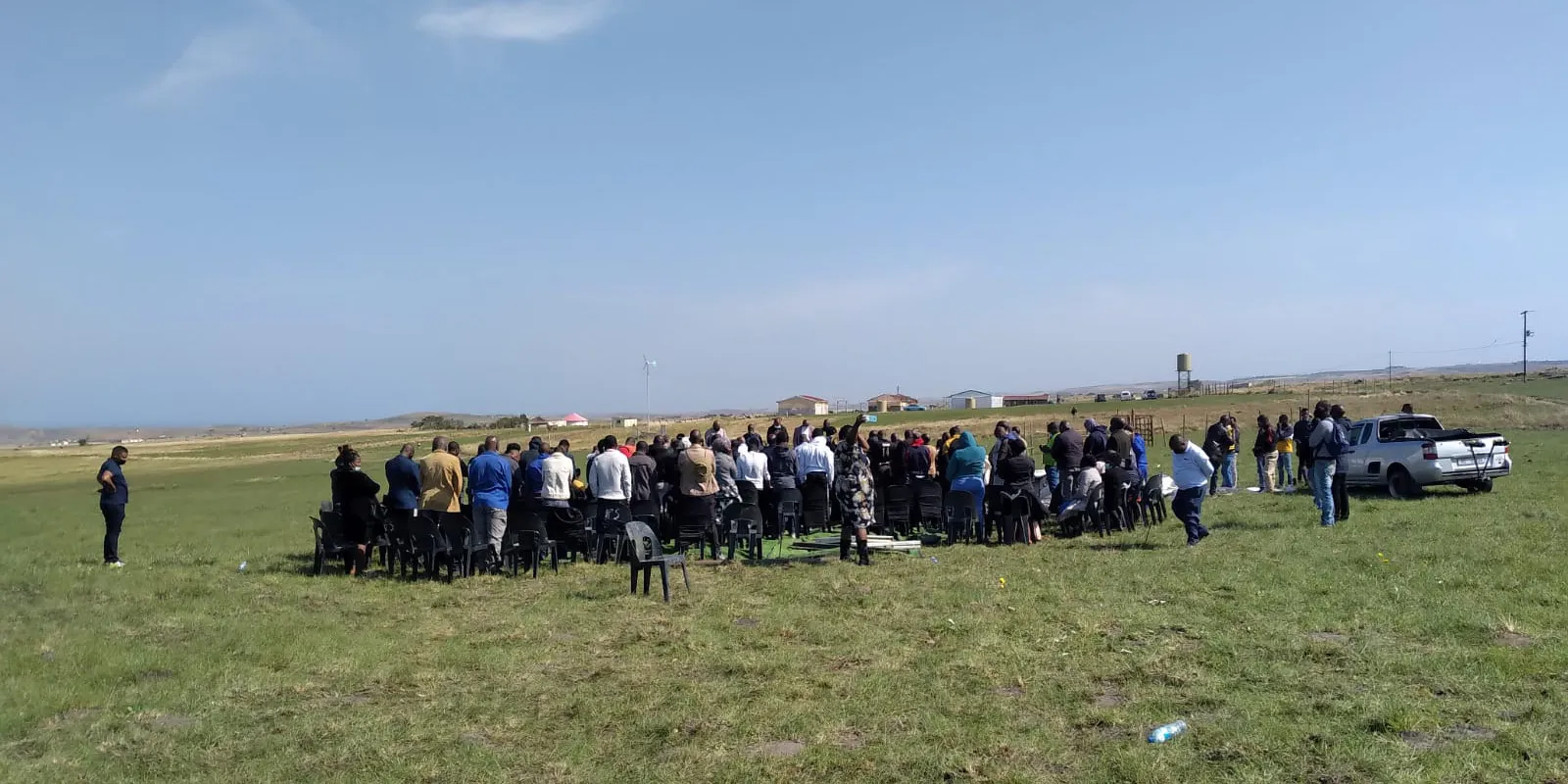
The MEC’s meeting with ‘stakeholders’ in Sigidi on 10 September. (Photo: Siyabonga Ndovela)
Smart City
The subject of the “Smart City” also came up again. At a meeting on 20 August in Bizana, the MEC had spoken of the Smart City in Mbizana. The executive mayor of Alfred Nzo District Municipality agreed that it would be built in Mbizana. Mantashe had also spoken about it in a television interview in 2019. He spoke about titanium sand mining, tourism and “a Smart City” – everything in Xolobeni. “Why not?”
But on 10 September, the MEC claimed, “No, it will be in Port St Johns!” It is always important to keep all locals uninformed.
On 26 September, the Sunday Times reported that the ANC has “closely guarded plans to build a new city on the coast between Port St Johns and Margate” – which is the Amadiba coast.
If you want a “Smart City” before you repair and renovate all broken towns there is a lot of empty land to consult about. Only 15km from the coast we have a large abandoned sugar cane field where the Lurholweni township ends. Do you prefer forced removals, like the apartheid government?
‘Busing in people’
The N2 project manager Craig McLachlan has accused the ACC of “busing in people” to the 10 September meeting. The MEC makes laughable comments in the Daily Dispatch newspaper that he had to block “outsiders”. Not even the people he bused to Sigidi attended his meeting.
We certainly had organised transport from rural villages in Umgungundlovu. On 3 September in inland Dangeni, Madikizela shamelessly declared that he would bus in people from the township to Sigidi to organise a “community imbizo” on 10 September.
We had one week to prepare for the meeting. The right place for meetings about land is our Komkhulu (traditional court). Our customary law is protected by the Constitution. We organised transport from Khombuza, Bekela, Mtentu, Mpindweni, Xolobeni and Mdatya in Umgungundlovu where Sanral’s N2 would pass through or which would be affected by the huge coastal projects that the coastal route is designed to support.
The MEC, his businessmen friends and the mining lobby bused in people from Ebenezer and Zikhuba in the Lurholweni township, and from inland villages Gumzana, Tophozo, Dangeni, Lityeni, Sdanga and Mahaha; villages that are nowhere near the N2 route. Sdanga and Lityeni are closer to Bizana than Sigidi. Tophozo is close to R61. Mahaha is 10km inland from Sanral’s route through Sigidi and Mdatya. The others are north, or way north, of Sanral’s route. There were no government transports to Sigidi from the coastal villages.
They say that the N2 is a “linear development”. What does the MEC think? Is the N2 like the spots on a leopard?
Amadiba and its traditional authorities
McLachlan refers in his comments in the Daily Maverick article to 50,000 members in the Amadiba “tribe”. He also says, “the ACC and their lawyers have no legal or ethical right to claim or even imply they speak on behalf of any community within the Amadiba Traditional Area.” His other statements have been refuted before in Daily Maverick by our lawyer Johan Lorenzen.
Amadiba is not a “tribe”. It is a large administrative area. It has a coastal and an inland section. They were decided 70 years ago. Most residents are part of one million AmaMpondo, which is our tribe. In cases before the court, our lawyers represent the coastal Umgungundlovu Traditional Authority, which is made up of the Headwoman’s Council and villagers gathered at meetings at our Komkhulu. They also represent the ACC and signed individual land rights holders. In two High Court judgments we won against the mining company and the Department of Mineral Rights and Energy, the judges had no problem with that.
As ACC, we know Amadiba intimately.
If there are “50,000” in Amadiba, then about 10,000 stay in the coastal Umgungundlovu area while some 25,000 stay in Lurholweni township. Land claimant families and people who have moved in to get a job at the Wild Coast Sun stay in Lurholweni. Some 15,000 are staying inland in rural Amadiba. The Dangeni and the Umgungundlovu Komkhulu handle land issues inland and on the coast separately.
One is not above the other, no matter what the mining lobby tells McLachlan.
We had a committee under Chief Lunga Baleni after a joint Amadiba imbizo on 23 January 2020. The imbizo decided to negotiate a new N2 route. The committee included members of both councils, the ACC and the small business organisation Umbono Wethu. The imbizo and this committee brought the Amadiba Traditional Authority to life. It had been in crisis since Chief Baleni became a mining director. The ACC and Umbono Wethu were on the committee to help solve the N2 issue with Sanral.
The committee collapsed after September 2020. Pressure was put on the chief. Umgungundlovu Council members and ACC were not invited to new secret meetings with Sanral.
The damage to the Amadiba
The damage to village relations in Amadiba will take time to heal.
On 9 September the ANC councillors held three mass meetings in the Lurholweni township. The halls were packed. People even stood outside. People are desperate because of the lockdowns of Wild Coast Sun. The councillors told people that the crisis committee was “blocking development” as a “small minority”.
There must have been a thousand people at the meetings.
A question put to the councillors was: “What is the difference between tomorrow and when we were bused to Mantashe’s meetings in Xolobeni, but saw that people don’t want mining?”
The next day most of them did not attend the Sigidi meeting.
‘I will build a hotel in Sigidi’
Before all this, on 20 August there was something like a first negotiation in Bizana about how the N2 would affect the coastal villages of Amadiba in Mbizana. A week before, the municipal manager and an official from the provincial transport department even visited Sigidi.
Mbulelo Petersen and Nwabisa Ngxumisa represented Sanral in Bizana on 20 August. Beside Madikizela; Polelo Mohale, the executive mayor of Alfred Nzo District Municipality; Daniswa Mafumbatha, the mayor of Winnie Madikizela-Mandela Local Municipality; Chief Lunga Baleni and five ACC delegates representing seven villages attended.
Madikizela insisted without success that members of the mining lobby attend the meeting. This was in breach of the 7 June agreement to have separate and undisturbed negotiations. After this, he dominated the meeting.
“I don’t want to hear about sweet potatoes, livestock and protecting the land for the next generation. What is that? People have no plan and no money to develop the land. We will open up your area for business. It will never be like before. We need your area to look like Margate or Umhlanga,” he said.
Who lived in the areas that became Margate and Umhlanga, Mr Madikizela, and where are they now?
Of course, there are always indigenous and local plans for development, but they are not supported from the top. They are undermined by Western capitalist plans for profit, as demonstrated by this comment from you: “Those in the ANC who steal money from the state and spend them in Dubai in big hotels should come and spend them here. Even myself, I will build a hotel in Sigidi. I have already talked to your councillor.”
Madikizela also commented: “Dubai is rich. They have oil,” and “You are sitting on gold.” On that note, he declared his friendship with our local Zamile Qunya, recently promoted to non-executive director in the Australian mining company MRC.
Mining on the coast is again put into a separate coastal Local Spatial Development Framework (LSDF), secretly adopted on 26 March 2020.
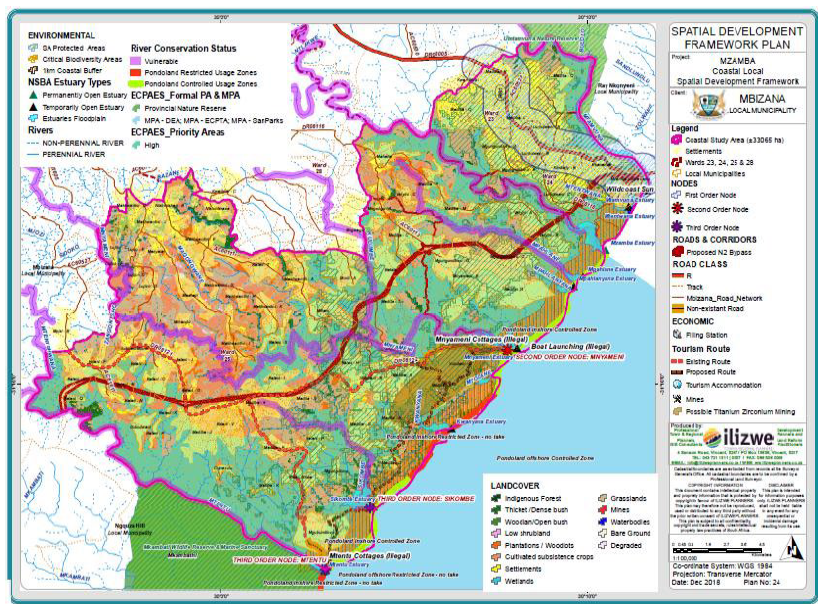
A map of ‘Mzamba/Coastal Local Spatial Development Framework’.
In March this year, we saw that this special LSDF was mentioned in the 2021 Integrated Development Plan (IDP). Officials demanded a Promotion of Access to Information application to hand over a document adopted by councillors without public participation, but they gave up on 14 June.
The hidden until June coastal LSDF marks out a 1,300ha large open-cast “possible titanium mining” area. Our Komkhulu is in its centre. The IDP says: “The mining potential assessment was done for the local investors to tap into available opportunities.”
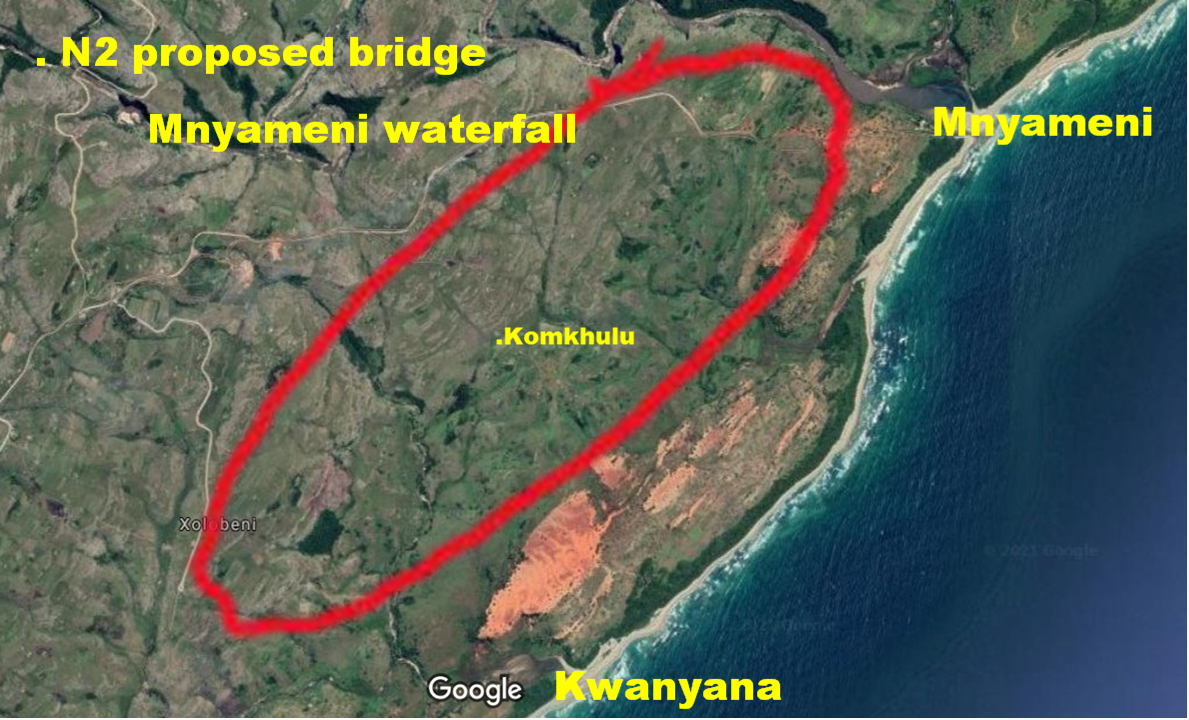
The open cast mining area in the silently adopted 2020 LSDF (Highlighted in a map made by ACC’s legal team).
The IDP repeats the plan for a “town on the coast”. “An investor” is set to take over the always fully booked Mtentu Lodge and campsite owned by the community. The LSDF speaks of a “conference centre for 120 people”, “luxury chalets” and “a restaurant” in the Mnyameni River conservation area.
Who has told the government that the problem of unemployment and poverty in South Africa can be solved by turning a rural area into a city? DM/MC/OBP
Write to [email protected] to get the 2020 ‘LSDF’ that surfaced in June 2021. It is not published on the municipality website.









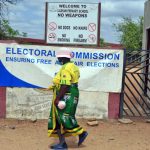











The Amadiba Crisis Committee (ACC) operates on the “Illusionary Truth” principal successfully used by all conspiracy theorists – namely if people hear something often enough they tend to believe it to be true despite a lack of evidence. Very little of what Ms Mbuthuma writes above is not a half-truth, uncontextualised misdirection or even outright lies.
The real tragedy is that the organisation that provided the locus standi for some valuable court victories for the rights of communities affected by mining would actively seek to deny the very communities they claim to fight for, one of the very right their lawyers fought for – namely the right to full and accurate information and the ability to make informed decisions. The ACC ignore the outcomes of Komkhulus and negotiations, misinform their supporters, tried to stop the Sigidi meeting and then cry foul when it still proceeded.
Everywhere in the Amadiba area and even amongst the ACC’s own few hundred rank and file supporters there is a widespread support for the N2 Wild Coast Road project to proceed as planned and approved in 2011 after a full EIA.
The ACC leadership and their lawyers have been provided with the evidence that there is no feasible route further inland as there are both no suitable bridge sites further inland across the massive Mzamba Gorge and no way to avoid displacing several hundred families in the densely populated areas between the Mzamba and Mtanvuna Rivers…as was found in the EIA in 2008/9.
Just a few of the key corrections
1. 1. Nonhle Mbuthuma may be “from” Sigidi but lives in KZN in a comfortable house with electricity, water, sewerage and tarred roads – unlike the residents in Sigidi and every other village in the Amadiba area.
2. The meeting on 10 September was for the Sigidi community to decide on signing a “Community Access Agreement” with SANRAL. It was not a meeting called to decide on moving the N2 road. Extensive public input, meetings and legal procedures regarding the route and possible alternatives were already concluded in 2008 and 2009. The legal approval for the route was granted in 2010 and upheld on Appeal in 2011. No-one in government or within communities has the legal authority to move (or block) the route approved in terms of proper legal process.
3. The ACC have already fought and in 2019 lost their case trying to overturn the Environmental Approval in the Pretoria High Court. Amongst the judges findings were that the public consultation was one of the most comprehensive ever undertaken in SA and that alternative routes had been adequately studied and considered in reaching the record of decision. The “inland mzamba” route the ACC are still trying to promote was studied and found non-feasible for a high mobility freight route during the initial public scoping study. On top of requiring the relocation of several hundred families in the Lurholweni township the inland route would require 2 additional mega bridges or 2 slow 70km/h passes.
4. The main reason the meeting was five hours late was because of the provocative and disruptive actions of the group of about 50-100 toy-toying ACC supporters who tried to prevent the meeting from taking place. It could only be finally convened with the POPs on hand to physically prevent the ACC from disrupting it further.
5. Because the number of pro-development, pro-N2 Sigidi stakeholders vastly outnumbered the anti-N2 Sigidi stakeholders in the meeting and because the stakeholders at the meetings were advised that the Komkhulu meeting required by communal law had already taken place at Dangeni deflating the few objections received the ACC has tried to delegitimise the meeting, its participants and its outcome.
6. The ACC does not recognise the legitimate pro-development views held by other stakeholders and labels anyone not supporting the ACC as corrupt, uncaring and ‘evil’ supporters of the mining company. With regard to views on the N2 Wild Coast Road this unfortunate put the overwhelming majority of local residents and stakeholders into this category.
7. According to the king and chief the aMpondo are a Nation not a tribe and the aMadiba are a Tribe not an administrative area. I used this terminology respectfully
8. Census figures give the 2011 population figures for people living within the aMadiba A/A as being almost 50,000 persons and 10,000 families – no quotation marks required.
9. The mandate accepted by the high courts from the “Umgungundlovu community” was the mandate given by the traditional authority to the Headlady for her to represent the “Umgungundlovu Community” in the court actions against the mining company. It was not a legal mandate to either the ACC or Richard Spoor lawyers to represent the community, nor was it a mandate to fight against the N2 Wild Coast Road. I will repeat that neither the ACC or RSI have a legal or ethical mandate to claim to represent or speak on behalf of any community or village in the aMadiba area.
10. The komkhulu that sits at Dangeni is for the aMadiba Traditional Council that includes both the inland and coastal sub-authorities and communities. Issues that affect both Inland and Coastal communities, such a request to move N2 route from the Coastal area to the Inland area, must be taken to the Dangeni Komkhulu where all parties can be represented. This is in terms of both communal law and common law. The ACC and their lawyers however do not appear to recognise or acknowledge any decisions made in terms of “communal law” that does not suit them.
The ACC is hell bent on keeping the Eastern Cape in poverty – hard to comprehend such a destructive agenda.
11. While local “communal law” does encourage consensus in community decisions, this is not absolute, particularly where consensus or compromise cannot be reached and/or a small minority cannot be persuaded to accept or accommodate the views of the majority. In these cases, and as has already occurred with regard the N2, the elders make a final decision for the greater good of the community. In terms of local “communal law” all residents must accept and respect these decisions even if they do not agree with them (This is the universal greater good principle). The ACC leadership have attended several komkhulu meetings at Dangeni as well as one at Umgungundlovu together with SANRAL and representatives and traditional leaders from both Inland and Coastal communities where consensus could not be reached. However the ACC refuses to acknowledge or respect any of the determinations made at the conclusion of these komkhulu meetings, or by the committee set up after the Umgungundlovu komkhulu, that were in favour of the implementation of the N2 as legally approved, against requesting government to reopen the EIA process to try move the N2 and/or in favour of SANRAL proceeding with community meetings within each village to sign off “Community Access Agreements”.